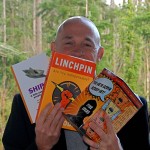Seth Godin and I go way back.
Not that I’ve actually met him yet but I’ve been reading Seth Godin’s books since about 2000. The book that changed the way I communicated for organizations and nonprofits was Purple Cow (how’s that for a killer title?). What I’ve always appreciated about Seth is that he’s a painfully straight-shooter, has big ideas, is not afraid to fail and understands giving back.
We’ve mentioned Seth and his thinking on the blog, our Twitter stream and on our Facebook page countless times as well as always having one of his books on our must-read booklist when we speak. Linchpin was the book that inspired our team and made for some spicy conversations with the Oneicity Tribe. Linchpin helped us be better at being us. If you don’t read his blog, you’re missing out on fresh, provocative thinking.
So a few weeks ago I mentioned Seth in a blog post and he commented. It was just a crack about my haircut, and I was sure it was from a spammer. But I emailed him looking for some sort of verification that it wasn’t one of my “friends” harassing me. Turns out it was the real Seth Godin with a real Seth Godin email address who responded to my email with: “It’s me.” How fun is that?
Thereafter Seth graciously agreed to do a short interview for our blog as part of our 8-in-8 book giveaway  because this week we’re giving away the whole Seth Godin Enchilada : the special edition boxed set (which is no longer available), plus Linchpin, and we’re throwing in one of the SHIP IT workbooks.
because this week we’re giving away the whole Seth Godin Enchilada : the special edition boxed set (which is no longer available), plus Linchpin, and we’re throwing in one of the SHIP IT workbooks.
ST: First, thanks so much for agreeing to take time to share your thoughts on nonprofits. Your time is short, so I’ll jump right to it. I gather that you personally support charities and causes. Can you describe what attracts you to a charity? What motivates you to make a gift or to support the organization?
 Seth: I think philanthropy is undermarketed, and that the typical middle class and up American is missing something by not experiencing the impact that giving can have. Last year Americans spent more than six billion dollars on self-storage facilities. What are we storing? What happens when you try to scale giving instead of taking or spending?
Seth: I think philanthropy is undermarketed, and that the typical middle class and up American is missing something by not experiencing the impact that giving can have. Last year Americans spent more than six billion dollars on self-storage facilities. What are we storing? What happens when you try to scale giving instead of taking or spending?
My personal objectives in giving are to fix the system, not to address emergencies. The endless emergency of poverty is a little depressing to me, and so a finger in the dike isn’t my goal.
ST: What do you think is the biggest mistake charities and nonprofits make in their marketing and fundraising?
Seth: Failing to treat different customers differently. And trying to always find another stranger, instead of wooing the friends already found. And high overhead events like galas.
ST: Love what you’re saying, we talk about that a lot in segmentation, granular messaging and wooing lapsed donors. That makes sense to us. So what’s the role of “story” in fundraising for a nonprofit?
Seth: That’s all there is. All we sell is a story, never more so than at a nonprofit.
ST: That’s where figuring out the Purple Cow concept and the ideas from All Marketers Tell Stories comes to play. OK, to shift gears a bit, most nonprofits struggle to recruit and retain great people on staff, how could the leader of a nonprofit use your Linchpin concept to build and keep a team?
Seth: Many non profits are afraid of the irreplaceable, they seek compliant cogs. They fear someone who will offend or shake things up or move too fast or demand to be measured. I think that’s a shame. This is particularly true with the old and famous charities, the ones we grew up with…
ST: Fear is a killer for many of us, not just in the nonprofit world. Thanks for writing so much about it and suggesting ways to conquer it (Linchpin). One of our readers will get your boxed set of books plus Linchpin. Which book would you recommend they read first with and why?
Seth: The order I wrote them is probably best, unless you think you’re going to get tired along the way, then I’d vote for The Dip, Linchpin, Tribes, Purple Cow, Permission Marketing and Catcher in the Rye. I didn’t really like that one, so read it last.
ST: Hilarious. Thanks a ton for making time for our readers.
There you have it straight from The Man. If you’d like a shot at getting the whole set (you do know that he was kidding about Catcher in the Rye don’t you?) comment this week on the blog or our Facebook page. One lucky commenter will score the whole thing except Catcher in the Rye (you’re killing me Seth).
So, what about you. Have a favorite Seth Godin book you’d like to tell us about? What do you think about what he has to say about nonprofit fundraising? More and more donors are fatigued by emergencies, yet crises are easy strategies for quick money. You’ve heard what Seth thinks, now tell us what you think.
As always, we love having you drop by.
st

Steve Thomas
Partner, Oneicity
(Seth photo credit: Wikipedia)


29 thoughts on “Oneicity interviews Seth Godin on fundraising”
Tribes was the most important book. As a person who works with people in the music industry, having the “1,000 person fan tribe” as the tipping point for real success changes the way bands market and play. Godin is spot on. Once you get 1,000 people who “like” you, filling venues for shows is easy(er), and the money starts to rise. (Oh, they aren’t making enough to quit their day jobs, but that day is coming.)
Good stuff. Seth Godin sounds like an interesting guy.
And, I liked Catcher in the Rye.
Brad
As you know I wouldnt be caught dead reading Catcher (maybe caught alive)
Hey how about Steve doing his thing?
How many of you would have even asked Seth for anything?
Turns out busy(and wealthy)people like it when smart people ask smart questions.
Nice work Hoots and Thomas
“Last year Americans spent more than six billion dollars on self-storage facilities. What are we storing?”
My brother and my mother are poor. This a true story. He doesn’t do computers and my mother doesn’t own one, so the chances of them reading this disclosure are next nil…and they also have different last names. She is elderly, lives on social security and needed to sell the modest house we grew up in as it was too difficult to keep up with the maintenance. It was full of stuff- 95% junk. The only thing of real value to me were the pictures. However, my brother insisted Mom fill a large self-storage unit with all the junk just in case he decided he wanted anything. (I am not even going to try to explain their relationship.) The stuff put in storage was the stuff that did not sell at my mom’s “moving sale” – even on the last day when everything was drastically reduced. So she has spent $400 a month of her meager social security check to keep the junk, just in case. That’s $4800 a year. I don’t want to tell you how many years this has been going on because it will make my mother and brother seem insane. Also, my sister and I. We enable my mother her to continue this appalling waste of resources as we continue to subsidize her income.
It is insane.
And after learning about the six billion – thats B as in BILLION!!! – spend on self-storage units yearly – as a culture we are out of our minds – a bunch of lunatics – masquerading as a sophisticated culture.
Thanks for the provocative post!
I love Seth’s hair cut, his blog and Linchpin. It’s the only book of his I’ve read (hint hint).
“All we sell is a story”, three thumbs way up on that quote.
six billion would solve almost three-quarters of the world’s contaminated water problem, and prevent a child dying every 15 seconds from deadly water…it’s not a math thing- it’s a heart thing…
I was introduced to Purple Cow last year and it really impacted how I write. I’m with Bill . . . love the idea that “all we sell is story.” I’m keepin’ that one.
@Bruce. Right you are. We haven’t lost our minds, we lost our hearts.
NICE job Steve and Hoots!! I do agree – all of us are selling a story – the story that will change our block, community, city, country and the world.
@Brad — What I loved about Tribes, is that Seth put into a format/formula something that many of us knew intuitively yet didn’t have a framework for it. That’s the genius, being able to frame it and articulate the situation.
A few people who love you are always better than thousands who like you.
That’s what makes the gathering here on the Oneicity blog and FB pages so much fun. It’s people with a common cause, concern for changing the world and a heart for fun!
Thanks as always for being on our side. (You win the early bird award, we weren’t pushing this out until tomorrow, you totally scooped everyone–you’re on all the time).
st
@Jim — I have so few strong feelings about Cather in the Rye, I guess I’m going to need to re-read it.
I’ve learned from you, Henderson, asking is a good thing. While it is some what out of your usual scope, I think you could help many Major Donor reps/officers. You know how to “ask” without it feeling anything but wonderful for everyone involved.
Thanks for your affirmations.
st
@Deborah — “Stuff” as power over us. That’s just the reality. Some are more controlled by it than others, but it is a powerful force. I was startled by Seth’s comment as clearly many have been.
Thank you for sharing so candidly. Your heart and concern for people always challenge me to be better.
So, how do we conquer the power “stuff” has in our lives? Around here, we’re working away from stuff and toward experiences and making memories.
What do you think?
st
@William — it’s all about the haircut! If you had to only choose one book, Linchpin’s a good one for you. Purple Cow will also light up your branding-brain. Hope you win, if not, spend some money and buy the book. It’s worth it.
st
@Steve – I think if you make those memories with me…they will be more memorable.
@Bruce — you were grabbed by that stat too, huh? I’m thinking not only about the reality Seth stated, but how framing it way he did increased the power of his statement. Expect to read more about this concept in the days ahead.
Thank you for sharing in the discussion. Let’s keep talking.
st
@Stacey — Purple Cows! Once you get it, it stays with you doesn’t it? One of the things that Seth does so well is take a clear concept then “play” with it a bit and then stop. His books aren’t long but they make the point, make it clearly and stop. Beautiful.
Thank you for joining in. We always love hearing from you.
st
@Deborah @Bruce “Haven’t lost our minds, we’ve lost our hearts.” Whoa that’s an indictment, isn’t it?
Thanks for pointing that out.
st
@Carol — You are so right, story is key. And you have learned and proved that lesson.
I remember how many times you and I went round and round finding the right story to help connect with donors. Thanks for never letting us settle for a “good enough” story. The right story of changed lives touches donor hearts.
Thank you!
st
What a coup to interview Seth Godin, Steve – kudos! Re my personal favorite book, Linchpin, you said it best: Linchpin helped us be better at being us.
As Seth noted, failing to differentiate our donors and always looking to find new donors rather than properly stewarding those that we already have is surely the vicious cycle all too many nonprofits are engaged in. Of course it’s hard to really love your donors if you don’t know who they are, so an understanding of your data is crucial. Next up: killer targeted copywriting.
And don’t even get me started on events.
We can’t allow ourselves to get bogged down in fear and lack. Thinking abundance and possibilities will take us so much further.
Thanks for a great post (as usual) Steve!
(PS: Does having been a previous book winner disqualify me from this entry? 🙂
@Pamela — Everyone is always eligible to get the book. No worries. Love your focus on abundance. I am certain that’s a huge key to success in the NPO world, as well as life.
As to data and targeted copy, we say you should treat every donor as if they were your ONLY donor. It makes a huge difference in perspective and strategy.
Thanks for your perspectives. Glad to know Linchpin was an important book for you. I’m not surprised.
st
Nice interview. I thought “Purple Cow” was a good read.
@Mark — thanks for dropping by. Purple Cow was wonderful–short read, big concept, applicable to almost any situation.
st
Steve, I always appreciate your heart which longs to inspire others to get good things done. Out of what Seth has shared in his blogged time with you I believe the “jewel” is his strong point that responding competently to compassion’s needs is about building systems, rather focusing emotionally on the perpetual available emergency. Seth is spot on. Non-profits often avoid building continuously improving systems while crying out for constant needed resources. A ton of money gets thrown into unintentionally perpetuating these never ending emergency cycles. At AK we are committed through our consulting provisions, and through our new non-profit enterprise efforts in reaching more people, to help compassionate organizations do what they do better. If you send us the Seth book set we will pass them on to one of the great small non-profits we help as part of defined competency development pathways (intentional learning). Just today a 19 year old kid from Kansas launched a smart, and potentially lasting, logistical solution for a village in Kenya. Seth’s ability to speak truthfully for real world dream makers is always a blessing to take in. I am grateful to be part of his tribes too. Thanks so much for sharing these moments. Cathie
@Cathie — Thanks for your input. Seth struck a chord with his call for solutions rather than constant emergency appeals.
I think that most donors want lasting solutions. I think it is interesting to consider what a “lasting” solution looks like. What’s the time horizon on a lasting solution versus an emergency?
I have some thoughts rolling around in my brain about this since we’re involved in helping organizations feed people on a daily basis…(among other things).
You bring up another interesting phenomenon, that of start-up NPOs. These start-ups often have lower overhead and are tough “competition” to existing longer tenured NPOs who have long track records.
It’s a wild, wild nonprofit world, isn’t it? I’m glad you’re one of the pros out there helping sort it out. What a fun ride!
So, what do you think, what’s the difference between a lasting solution and an emergency that never ends…just the time horizon?
I’m thinking…love to know what the Oneicity Tribe thinks.
(Cathie–you make a great case for winning, it’s a random number generator that chooses who gets the book. Glad I don’t have to decide!)
st
Hey you inspired us with the “Seth-set” random win. Whether we win by number or not we will give a set to a small non-profit.
Pingback: oneicity // income solutions for non-profits » what if churches thought like nonprofits?
Pingback: oneicity // income solutions for non-profits » billions on storage units
@Cathie — I should have asked Seth for a cut of all the books that our Tribe gives away!
It’s all about giving away…good stuff.
st
@ Steve…You bet it is all about sharing good stuff. Something tells me that Seth’s cut is in the joy and anticipation others feel in your good idea.
I’m with Brad S. on Tribes, perhaps, being Seth most important work for me. It has helped me formulate and communicate the importance of venturing into Social Media and relying more on guerilla techniques rather than mass media. The Dip is also very valuable as an encouragement to stay the path when others drop out. I do recommend all his writings to my friend and clients. His daily blog, in particular, keeps it real!
Comments are closed.